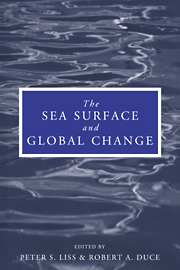Book contents
- Frontmatter
- Contents
- List of contributors
- Preface
- 1 Report Group 1 – Physical processes in the microlayer and the air–sea exchange of trace gases
- 2 Report Group 2 – Biological effects of chemical and radiative change in the sea surface
- 3 Report Group 3 – Photochemistry in the sea-surface microlayer
- 4 Transport processes in the sea-surface microlayer
- 5 The role of organic films in air–sea gas exchange
- 6 Bubbles and their role in gas exchange
- 7 The physical chemistry of air–sea gas exchange
- 8 The sea-surface microlayer and its effect on global air–sea gas transfer
- 9 Chemistry of the sea-surface microlayer
- 10 Biophysics of the surface film of aquatic ecosystems
- 11 Biological effects of chemicals in the sea-surface microlayer
- 12 Neuston of seas and oceans
- 13 Photochemistry in the sea-surface microlayer
- 14 Hydrocarbon breakdown in the sea-surface microlayer
- 15 Applications of laser technology and laser spectroscopy in studies of the ocean microlayer
- 16 Remote sensing of the sea-surface microlayer
- Index
7 - The physical chemistry of air–sea gas exchange
Published online by Cambridge University Press: 24 September 2009
- Frontmatter
- Contents
- List of contributors
- Preface
- 1 Report Group 1 – Physical processes in the microlayer and the air–sea exchange of trace gases
- 2 Report Group 2 – Biological effects of chemical and radiative change in the sea surface
- 3 Report Group 3 – Photochemistry in the sea-surface microlayer
- 4 Transport processes in the sea-surface microlayer
- 5 The role of organic films in air–sea gas exchange
- 6 Bubbles and their role in gas exchange
- 7 The physical chemistry of air–sea gas exchange
- 8 The sea-surface microlayer and its effect on global air–sea gas transfer
- 9 Chemistry of the sea-surface microlayer
- 10 Biophysics of the surface film of aquatic ecosystems
- 11 Biological effects of chemicals in the sea-surface microlayer
- 12 Neuston of seas and oceans
- 13 Photochemistry in the sea-surface microlayer
- 14 Hydrocarbon breakdown in the sea-surface microlayer
- 15 Applications of laser technology and laser spectroscopy in studies of the ocean microlayer
- 16 Remote sensing of the sea-surface microlayer
- Index
Summary
Abstract
The thermodynamics and kinetics of air–sea exchange are discussed in terms of the underlying theory and on the basis of numerical calculations. The thermodynamic driving force for gas exchange is dependent on the air–sea temperature difference as well as on the partial pressure or concentration difference across the interface. The kinetics of the exchange process are strongly affected by the surface temperature of the water, as controlled by the fluxes of sensible and latent heat. The results of calculations for a model which incorporates a turbulent air layer are compared with the experimental data of Liss et al. (1981), Smith and Jones (1985) and Smith et al. (1991). This comparison clearly demonstrates the importance of coupling, in the sense of Onsager's irreversible thermodynamics, of the fluxes of sensible heat and matter across the interface. The calculations also suggest a possible new approach to the measurement of air–water exchange rates for trace gases such as carbon dioxide.
Introduction
The rate of air–sea exchange of carbon dioxide is a topic which has been the subject of some controversy in recent years. This exchange rate, which is of great practical importance in connection with global warming, is very difficult to determine experimentally, and the difficulty is compounded by the need to obtain values for both the long-term average of the rate on a global scale and the local exchange rate at a particular instant.
- Type
- Chapter
- Information
- The Sea Surface and Global Change , pp. 207 - 250Publisher: Cambridge University PressPrint publication year: 1997
- 4
- Cited by



